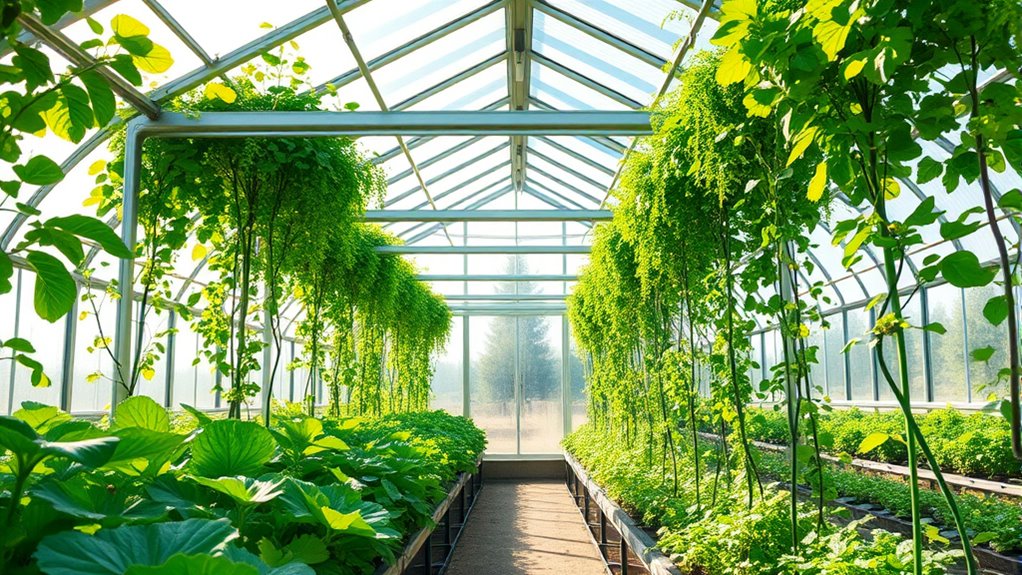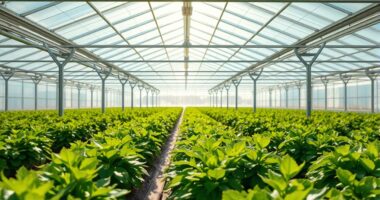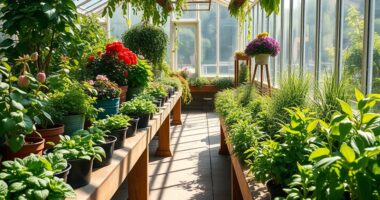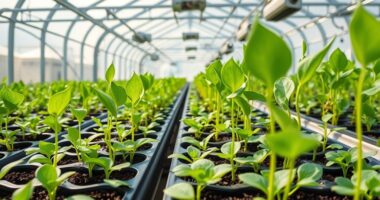Greenhouses create a controlled environment that helps your plants grow better by trapping sunlight and heat using transparent materials like glass or plastic. They regulate temperature, humidity, and light to extend your growing season, protect against pests, and reduce weather-related damage. By using ventilation, shading, and climate control systems, you can optimize plant health and yields. Keep exploring to discover more ways greenhouses can boost your gardening success and keep plants thriving year-round.
Key Takeaways
- Greenhouses trap sunlight and heat to create controlled environments for optimal plant growth.
- They extend growing seasons and protect plants from pests and harsh weather conditions.
- Key components include climate control systems, ventilation, reliable glazing materials, and monitoring technology.
- Using greenhouses enhances crop yields, promotes healthier plants, and allows year-round cultivation.
- Beginners should start with simple designs, choose suitable plants, and understand greenhouse materials and maintenance.
How Greenhouses Work

Ever wondered how greenhouses create such ideal conditions for plants to thrive? It all comes down to climate control and light management. Greenhouses trap sunlight and heat, maintaining warm temperatures even when it’s cold outside. They use transparent materials, like glass or plastic, to maximize sunlight entry while reducing heat loss.
Inside, ventilation systems help regulate humidity and temperature, preventing overheating or cold spots. Shade cloths or blinds can be used to control light intensity on particularly sunny days, preventing plants from getting scorched. Fans, vents, and heaters work together to maintain a stable environment. Climate control systems have become increasingly sophisticated, allowing for precise environmental adjustments tailored to different plant species. Proper storage of equipment and supplies is also vital for maintaining the efficiency of these systems. Additionally, automation in greenhouse technology has enabled more accurate and efficient environmental management. Incorporating air quality management through filtration and circulation can further optimize plant health and growth conditions.
This careful balance guarantees your plants receive consistent warmth, moisture, and light, giving them the best chance to grow healthy and strong, regardless of outside weather conditions.
Key Components of a Greenhouse

A greenhouse’s effectiveness depends on its key components working together to create an ideal growing environment. Climate control systems are essential because they regulate temperature, humidity, and light levels, ensuring plants thrive regardless of outside conditions. Proper ventilation systems, including fans and vents, play a crucial role by promoting airflow, removing excess heat, and preventing mold or disease. Proper ventilation also helps maintain consistent temperatures and humidity, which are indispensable for healthy plant growth. Additionally, your greenhouse should have reliable glazing material to allow sunlight in while insulating against extreme weather. Well-maintained climate control and ventilation systems can also maximize energy efficiency and reduce operational costs, making your greenhouse more sustainable and economical. Incorporating advanced monitoring technology can further optimize environmental conditions and improve overall plant health. For optimal results, it’s important to select vetted climate control options that meet safety standards and suit your specific needs. Together, these components help you manage the environment inside, making your greenhouse a productive and healthy space for your plants. Without well-functioning climate control and ventilation, your plants may struggle to grow optimally.
Advantages of Using a Greenhouse

Have you considered how a greenhouse can extend your growing season and improve plant health? Using a greenhouse offers significant advantages, such as protecting plants from pests and harsh weather, which aids in plant disease prevention. It also allows you to grow seasonal crops beyond their usual timeframe, increasing your harvest options. Here’s a quick look at these benefits:
| Benefit | Explanation | Impact |
|---|---|---|
| Seasonal extension | Grow crops outside normal seasons | More harvests per year |
| Disease prevention | Controlled environment reduces pests | Healthier, stronger plants |
| Pest control | Barrier against insects and animals | Fewer crop losses |
With these benefits, a greenhouse becomes a powerful tool for consistent, healthy gardening. Additionally, understanding the proper use of electric heated mattress pads can enhance your comfort during colder months.
Types of Greenhouses

Are you curious about the different types of greenhouses available? There are several options to *contemplate*, depending on your needs and budget. Glass structures are popular for their durability and excellent light transmission, making them ideal for maximizing sunlight. They often come as traditional, sturdy structures that can last many years. Additionally, glass greenhouses can support the growth of a wide variety of plants due to their superior light transmission qualities, which is essential for plant development. Alternatively, plastic options, such as polycarbonate or polyethylene, offer lightweight, affordable, and easier-to-construct choices. These are great if you’re just starting out or want a portable greenhouse. While glass provides a classic look and clear visibility, plastic options are versatile and can be customized to different sizes and shapes. Both types serve the same purpose but cater to different preferences and environment conditions. Different materials also influence the insulation qualities of a greenhouse, affecting temperature regulation and plant growth. For example, some plastics have better insulation properties that help maintain stable internal temperatures, making them suitable for various climates. Moreover, the choice of materials can impact the overall cost and maintenance requirements of your greenhouse, influencing long-term sustainability and ease of use. Understanding the historical significance of different greenhouse materials can also help you make more informed decisions tailored to your gardening goals, climate, and budget.
Tips for Starting Your Own Greenhouse

Starting your own greenhouse can be an exciting project, but it requires careful planning to guarantee success. Begin with a DIY design that fits your space and budget, ensuring it provides adequate sunlight, ventilation, and protection from harsh weather. Using self-watering plant pots can help maintain consistent moisture for your plants, reducing the need for frequent watering and promoting healthier growth. Focus on plant selection by choosing species suited to your climate and greenhouse conditions; start with easy-to-grow plants like herbs or leafy greens. Consider the materials you’ll use—polycarbonate, glass, or plastic—and how they affect insulation and light. Organize your workspace for easy access to tools and supplies. Keep a detailed plan of your setup and plant care routines. Regular maintenance and monitoring will help you troubleshoot issues early, giving your greenhouse the best chance to thrive from the start. Additionally, understanding greenhouse materials and their insulation properties can increase your setup’s energy efficiency and temperature control, ensuring optimal growing conditions. Being aware of the market trends related to gardening and greenhouses can also provide creative ideas and motivation to enhance your gardening journey.
Frequently Asked Questions
What Are the Common Pests Found in Greenhouses?
You’ll find common pests like aphids, whiteflies, and spider mites in greenhouses. To manage them effectively, practice pest identification early to spot infestations quickly.
Using natural pest control methods, such as introducing beneficial insects or applying organic sprays, helps keep pests in check without harming your plants.
Regular monitoring and maintaining a clean environment are essential steps to prevent pests from spreading and damaging your greenhouse crops.
How Do I Control Humidity Inside a Greenhouse?
Did you know that improper humidity regulation can lead to plant diseases and reduced yields?
To control humidity inside your greenhouse, you should use effective methods like misting systems to add moisture during dry periods and ventilation to reduce excess humidity.
Regular monitoring with a hygrometer helps you maintain ideal levels.
What Is the Average Cost to Build a Beginner Greenhouse?
When estimating the cost to build a beginner greenhouse, you should focus on budget planning and cost estimation.
Generally, you’ll spend between $500 and $2,500, depending on size, materials, and features.
Smaller, simple structures with basic materials are more affordable, while larger or more advanced greenhouses cost more.
Factor in expenses like framing, glazing, and ventilation to create an accurate budget and guarantee your project fits your financial plan.
Can Greenhouses Be Used for Year-Round Gardening?
Yes, greenhouses can be used for year-round gardening. They provide season extension, allowing you to grow plants beyond their usual outdoor growing season.
You can select plants suited for different times of the year and control temperature, humidity, and light. With proper ventilation and heating, you’ll enjoy fresh produce and vibrant flowers year-round, making your gardening experience more flexible and rewarding regardless of outdoor weather conditions.
How Do I Choose the Right Plants for My Greenhouse?
They say, “You are what you plant,” so choosing the right plants depends on your greenhouse’s growing conditions. Consider factors like temperature, light, and humidity when selecting plants.
Opt for species that thrive in your environment, whether you want vegetables, flowers, or herbs. Research each plant’s needs to make certain of healthy growth.
With thoughtful plant selection, you’ll create a thriving greenhouse oasis tailored to your climate and goals.
Conclusion
Now that you know the basics, building a greenhouse can be a rewarding project. Did you know that greenhouses can increase plant growth rates by up to 50%? With the right setup and care, you’ll enjoy fresh vegetables and vibrant flowers year-round. Remember, starting small is okay—greenhouses are adaptable and forgiving. With a little effort, you’ll create a thriving space that benefits both your garden and your happiness. Happy gardening!









